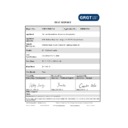JBL ON BEAT RUMBLE (serv.man4) EMC - CB Certificate ▷ View online
Report No.: EM201200813-4
Application No.:
ZJ00024740
Page 13 of 53
For 8DPSK
AC Power
25 ACnom
25 ACnom
2400.39
2481.62
FL>2400.0 FH< 2483.5
-20
ACmin 2400.47
2481.54
ACmax 2400.42 2481.57
+55
ACmin 2400.39
2481.61
ACmax 2400.47 2481.59
FL: Lowest frequency of the power envelope, it is the frequency furthest below the frequency
of maximum power where the output power drops below the level of –80 dBm/Hz spectral
power density (-30 dBm if measured in a 100 kHz bandwidth) eirp.
FH: Highest frequency of the power envelope, it is the frequency furthest above the frequency
of maximum power where the output power drops below the level of –80 dBm/Hz spectral
power density (-30 dBm if measured in a 100 kHz bandwidth) eirp.
NOTE: ACnom =AC230V/50Hz;ACmin = AC207V/50Hz; ACmax= AC253V/50Hz
TEST RESULTS: The unit does meet the requirements.
of maximum power where the output power drops below the level of –80 dBm/Hz spectral
power density (-30 dBm if measured in a 100 kHz bandwidth) eirp.
FH: Highest frequency of the power envelope, it is the frequency furthest above the frequency
of maximum power where the output power drops below the level of –80 dBm/Hz spectral
power density (-30 dBm if measured in a 100 kHz bandwidth) eirp.
NOTE: ACnom =AC230V/50Hz;ACmin = AC207V/50Hz; ACmax= AC253V/50Hz
TEST RESULTS: The unit does meet the requirements.
The test slots as below:
Report No.: EM201200813-4
Application No.:
ZJ00024740
Page 14 of 53
For GFSK
Low Frequency
:
High Frequency
Report No.: EM201200813-4
Application No.:
ZJ00024740
Page 15 of 53
For 8DPSK
Low Frequency
High Frequency
Report No.: EM201200813-4
Application No.:
ZJ00024740
Page 16 of 53
4.3 DWELL TIME
4.3.1 LIMITS
EN300 328 clause 4.3.4
The maximum dwell time shall be 0,4 s.
4.3.2 TEST PROCEDURE
Remove the antenna from the EUT and then connect a low attenuation cable from the antenna port to the
spectrum.
Set spectrum analyzer span = 0. centered on a hopping channel;
Set RBW = 1MHz and VBW ≥ 1MHz. Sweep = as necessary to capture the entire dwell time per hopping
channel. Detector Function = Peak. Trace = Max hold;
Use the marker-delta function to determine the dwell time. If this value varies with different modes of
operation (e.g.. data rate. modulation format. etc.). repeat this test for each variation. The limit is specified
in one of the subparagraphs of this Section. Submit this plot(s). An oscilloscope may be used instead of a
spectrum analyzer.
Pre-test the 3 modulation to find GFSK and 8DPSK is worse case, so only record GFSK and 8DPSK test
data.
4.3.3 TEST SETUP
Remove the antenna from the EUT and then connect a low attenuation cable from the antenna port to the
spectrum.
Set spectrum analyzer span = 0. centered on a hopping channel;
Set RBW = 1MHz and VBW ≥ 1MHz. Sweep = as necessary to capture the entire dwell time per hopping
channel. Detector Function = Peak. Trace = Max hold;
Use the marker-delta function to determine the dwell time. If this value varies with different modes of
operation (e.g.. data rate. modulation format. etc.). repeat this test for each variation. The limit is specified
in one of the subparagraphs of this Section. Submit this plot(s). An oscilloscope may be used instead of a
spectrum analyzer.
Pre-test the 3 modulation to find GFSK and 8DPSK is worse case, so only record GFSK and 8DPSK test
data.
4.3.3 TEST SETUP
4.3.4 TEST RESULTS
The test period: T= 0.4 Second/Channel x 79 Channel = 31.6 s
1.
Channel 0:
2.402GHz
DH1 time slot =0.387 (ms) * (1600/(2*79)) * 31.6 = 123.840 ms
DH3 time slot =1.651 (ms) * (1600/(4*79)) * 31.6 = 264.160 ms
DH5 time slot =2.918 (ms) * (1600/(6*79)) * 31.6 = 311.253 ms
2DH1 time slot =0.411 (ms) * (1600/(2*79)) * 31.6 = 131.520 ms
2DH3 time slot =1.659 (ms) * (1600/(4*79)) * 31.6 = 265.440 ms
2DH5 time slot =1.707 (ms) * (1600/(6*79)) * 31.6 = 182.080 ms
2DH3 time slot =1.659 (ms) * (1600/(4*79)) * 31.6 = 265.440 ms
2DH5 time slot =1.707 (ms) * (1600/(6*79)) * 31.6 = 182.080 ms
3DH1 time slot =0.409 (ms) * (1600/(2*79)) * 31.6 = 130.880 ms
3DH3 time slot =1.673 (ms) * (1600/(4*79)) * 31.6 = 267.680 ms
3DH5 time slot= 2.921 (ms) * (1600/(6*79)) * 31.6 = 311.573 ms
3DH3 time slot =1.673 (ms) * (1600/(4*79)) * 31.6 = 267.680 ms
3DH5 time slot= 2.921 (ms) * (1600/(6*79)) * 31.6 = 311.573 ms
2.
Channel 39
: 2.441GHz
DH1 time slot = 0.392 (ms) * (1600/(2*79)) * 31.6 = 125.440 ms
DH3 time slot = 1.656 (ms) * (1600/(4*79)) * 31.6 = 264.960 ms
DH5 time slot = 2.920 (ms) * (1600/(6*79)) * 31.6 = 311.467 ms
DH3 time slot = 1.656 (ms) * (1600/(4*79)) * 31.6 = 264.960 ms
DH5 time slot = 2.920 (ms) * (1600/(6*79)) * 31.6 = 311.467 ms
2DH1 time slot = 0.409 (ms) * (1600/(2*79)) * 31.6 = 130.880 ms
Antenna
EUT
Receiver
Click on the first or last page to see other ON BEAT RUMBLE (serv.man4) service manuals if exist.

